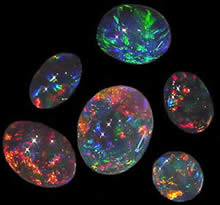|
Reviewed By Andreas Zabczyk
Gemstone Supply and Demand
Natural Australian Opal
The economics of the gemstone market would seem to be the same as for any commodity. The price will be a result of the supply and the demand. If demand for a particular kind of gemstone is low, prices will fall. But when prices fall, producers tend to cut back on production since their profits are small or nonexistent. Conversely, when demand exceeds supply, prices rise. This encourages producers to increase production, since there are good profits to be made. Economists express this fundamental law in terms of a tendency to equilibrium - in a competitive market, price will equalize the quantity demanded by consumers and the quantity supplied by producers. This results in an economic equilibrium of price and quantity. In mature markets with a well-established supply and demand, the law of supply and demand holds true. However, in certain sectors of the gemstone trade where the supply is unreliable and sporadic, this traditional economic principle becomes less applicable. In such cases, the unpredictability of supply directly impacts both prices and demand. As a result, the market becomes more volatile and challenging to forecast accurately. 
Natural Tanzanian Spinel
It is one of the paradoxes of the gemstone business that in many cases you need supply in order to have demand. A steady supply, especially when combined with good marketing, serves to increase demand and thus push prices higher. Economists call this induced demand, where increased supply actually serves to increase demand. It's a well-known phenomenon in the transportation sector, for example, where building new highways results in increased traffic. We saw this happen in the diamond business over a period of several decades. DeBeers controlled the supply of diamonds so that there was always a steady and reliable, but not excessive, supply. At the same time, they mounted a concerted advertising campaign to create an association between diamonds and love, courtship and marriage, under the now familiar slogan "Diamonds are Forever". The result was increased demand and higher prices for diamonds. In the case of many colored gemstones, uncertain supply has made it difficult for the jewelry industry to promote certain gems. There is no point in spending resources attempting to promote a product that is not available for sale. This means, for example, that the prices for scarce gems like natural spinel are not nearly as high as one would expect. If the supply was greater, spinel would be promoted more, and demand and prices would rise. 
Tanzanite Gem
Is this situation likely to change? In the case of many gemstones, the production is geographically dispersed. Sapphire, for example, comes from Sri Lanka, Madagascar, Myanmar, Tanzania, Mozambique, Australia, Thailand, Nigeria, Kenya and Cambodia. It is very difficult to control the supply from so many diverse sources. Where a gemstone comes from a single location, the task is much easier. Thus, much of the tanzanite supply and distribution has been controlled by TanzaniteOne, and prices have risen dramatically. The opal industry in Australia may be next to distribute and market their gems in a coordinated way; with 95% of world opal production in Australia, they may well succeed. This Page in Other Languages
|
| STAY IN TOUCH | NEWSLETTER |
| *You're signing up to receive GemSelect promotional email. |
Copyright © 2005-2024 GemSelect.com all rights reserved.
Reproduction (text or graphics) without the express written consent of GemSelect.com (SETT Company Ltd.) is strictly prohibited.
591